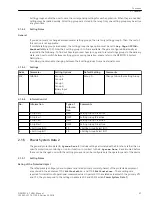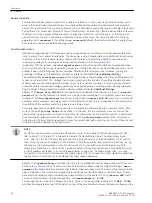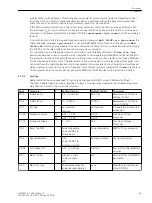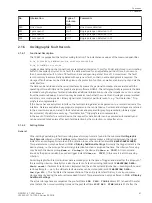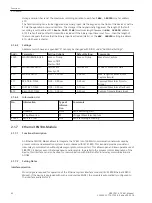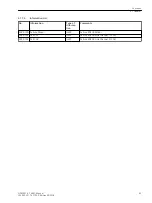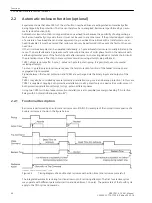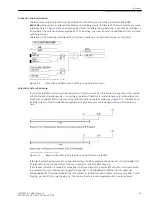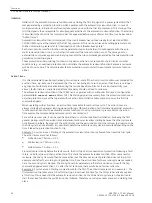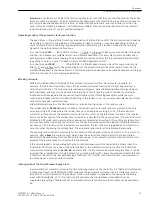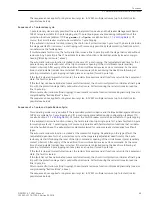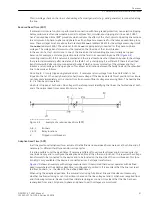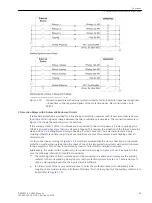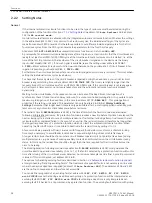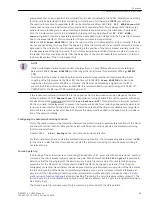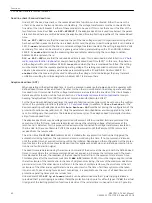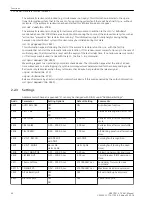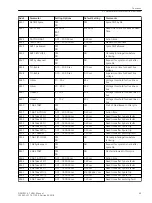
Multiple reclosure
If a short-circuit still exists after a reclosure attempt, further reclosure attempts can be made. Up to 8 reclosure
attempts are possible with the automatic reclosure function integrated in the 7VK61.
The first four reclosure cycles are independent of each other. Each one has separate action and dead times,
can operate with 1- or 3-pole trip and can be blocked separately via binary inputs. The parameters and inter-
vention possibilities of the fourth cycle also apply to the fifth cycle and onwards.
The sequence is the same in principle as in the different reclosure programs described above. However, if the
first reclosure attempt was unsuccessful, the reclosure function is not blocked, but instead the next reclose
cycle is started. The appropriate dead time starts with the reset of the trip command or opening of the circuit
breaker (pole) (auxiliary contact criterion). The circuit breaker receives a new close command after expiry of
the dead time. At the same time the reclaim time is started.
The reclaim time is reset with each new trip command after reclosure and is started again with the next close
command until the set maximum number of permissible auto-reclose cycles has been reached.
If one of the reclosing attempts is successful, i.e. the fault disappeared after reclosure, the blocking time
expires and the automatic reclosing system is reset. The fault is cleared.
If none of the cycles is successful, the short-circuit protection initiates a final 3-pole trip after the last permis-
sible reclosure, following a protection stage that is valid without auto-reclosure. The automatic reclosing func-
tion is blocked dynamically (see also above under margin heading “Blocking the Reclosing Function”).
Handling Evolving Faults
When 1-pole or 1-and 3-pole reclose cycles are executed in the network, particular attention must be paid to
sequential faults.
Evolving faults are faults which occur during the dead time after clearance of the first fault.
There are various ways of handling sequential faults in the 7VK61depending on the requirements of the
network:
To detect an evolving fault, you can select either the trip command of a protection function during the dead
time or every further pickup as the criterion for an evolving fault.
There are also various selectable possibilities for the response of the internal auto- reclose function to a
detected evolving fault.
•
EV. FLT. MODE
blocks AR
:
The reclosure is blocked as soon as a sequential fault is detected. The tripping by the sequential fault is
always 3-pole. This applies irrespective of whether 3-pole cycles have been permitted or not. There are
no further reclosure attempts; the automatic reclosure function is blocked dynamically (see also margin
heading “Blocking reclosure”, above).
•
EV. FLT. MODE
starts 3p AR
:
As soon as a sequential fault is detected, the recloser switches to a 3-pole cycle. Each trip command is 3-
pole. The separately settable dead time for sequential faults starts with the clearance of the sequential
fault; after the dead time the circuit breaker receives a close command. The further sequence is the same
as for 1- and 3-pole cycles.
The complete dead time in this case consists of the part of the dead time for the 1-pole reclosure up to
the clearance of the sequential fault plus the dead time for the sequential fault. This makes sense
because the duration of the 3-pole dead time is most important for the stability of the network.
If reclosure is blocked due to a sequential fault without the protection issuing a 3-pole trip command (e.g. for
sequential fault detection with starting), the device can send a 3-pole trip command so that the circuit breaker
does not remain open with one pole (forced 3-pole trip).
Dead Line Check (DLC)
If the voltage of a disconnected phase does not disappear following a trip, reclosure can be prevented. A
prerequisite for this function is that the voltage transformers are connected on the line side of the circuit
breaker. To select this function the dead line check must be activated. The automatic reclosure function then
checks the disconnected line for no-voltage: the line must have been without voltage for at least an adequate
measuring time during the dead time. If this was not the case, the reclosure is blocked dynamically.
Functions
2.2 Automatic reclosure function (optional)
50
SIPROTEC 4, 7VK61, Manual
C53000-G1176-C159-5, Edition 05.2018
Содержание SIPROTEC 4 7VK61
Страница 8: ...8 SIPROTEC 4 7VK61 Manual C53000 G1176 C159 5 Edition 05 2018 ...
Страница 10: ...10 SIPROTEC 4 7VK61 Manual C53000 G1176 C159 5 Edition 05 2018 ...
Страница 16: ...16 SIPROTEC 4 7VK61 Manual C53000 G1176 C159 5 Edition 05 2018 ...
Страница 176: ...176 SIPROTEC 4 7VK61 Manual C53000 G1176 C159 5 Edition 05 2018 ...
Страница 224: ...224 SIPROTEC 4 7VK61 Manual C53000 G1176 C159 5 Edition 05 2018 ...
Страница 264: ...264 SIPROTEC 4 7VK61 Manual C53000 G1176 C159 5 Edition 05 2018 ...
Страница 270: ...270 SIPROTEC 4 7VK61 Manual C53000 G1176 C159 5 Edition 05 2018 ...
Страница 276: ...276 SIPROTEC 4 7VK61 Manual C53000 G1176 C159 5 Edition 05 2018 ...
Страница 346: ...346 SIPROTEC 4 7VK61 Manual C53000 G1176 C159 5 Edition 05 2018 ...


